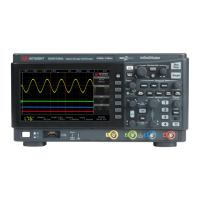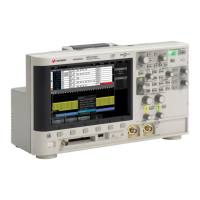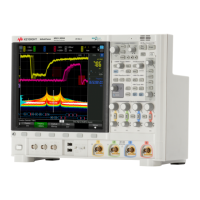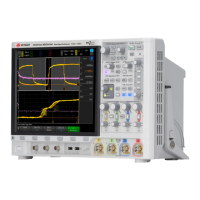638 Keysight InfiniiVision DSOX1204A/G Oscilloscopes Programmer's Guide
28 :WAVeform Commands
If the :WAVeform:FORMat data format is ASCii (see page 644), the data values are
converted internally and sent as floating point values separated by commas.
In converting a data value to time, the time value of a data point can be
determined by the position of the data point. For example, the fourth data point
sent with :WAVeform:XORigin = 16 ns, :WAVeform:XREFerence = 0, and
:WAVeform:XINCrement = 2 ns, can be calculated using the following formula:
time = [(data point number - xreference) * xincrement] + xorigin
This would result in the following calculation for time bucket 3:
time = [(3 - 0) * 2 ns] + 16 ns = 22 ns
In :ACQuire:TYPE PEAK mode (see page 189), because data is acquired in
max-min pairs, modify the previous time formula to the following:
time=[(data pair number - xreference) * xincrement * 2] + xorigin
Data Format for Transfer
There are three formats for transferring waveform data over the interface: BYTE,
WORD and ASCii (see ":WAVeform:FORMat" on page 644). BYTE, WORD and
ASCii formatted waveform records are transmitted using the arbitrary block
program data format specified in IEEE 488.2.
When you use the block data format, the ASCII character string "#8<DD...D>" is
sent prior to sending the actual data. The 8 indicates how many Ds follow. The Ds
are ASCII numbers that indicate how many data bytes follow.
For example, if 1000 points will be transferred, and the WORD format was
specified, the block header "#800001000" would be sent. The 8 indicates that
eight length bytes follow, and 00001000 indicates that 1000 binary data bytes
follow.
Use the :WAVeform:UNSigned command (see page 660) to control whether data
values are sent as unsigned or signed integers. This command can be used to
match the instrument's internal data type to the data type used by the
programming language. This command has no effect if the data format is ASCii.
Data Format for Transfer - ASCii format
The ASCii format (see ":WAVeform:FORMat" on page 644) provides access to
the waveform data as real Y-axis values without using Y origin, Y reference, and
Y increment to convert the binary data. Values are transferred as ASCii digits in
floating point format separated by commas. In ASCii format, holes are
represented by the value 9.9e+37. The setting of :WAVeform:BYTeorder (see
page 640) and :WAVeform:UNSigned (see page 660) have no effect when the
format is ASCii.
Data Format for Transfer - WORD format

